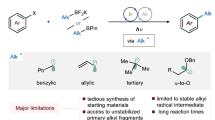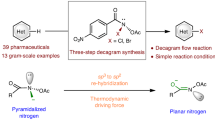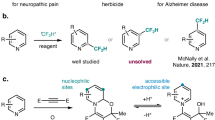Abstract
DI-ANETHOLE or iso-anethole (I) has been described by Kraut and Schlun1 and later by Orndorff, Terrasse and Morton2 as an unsaturated liquid dimeride of anethole. Its structure was established by Goodall and Haworth3, who obtained from it, by oxidation, anisic acid and a ketone, which was identified as (II) by synthesis.
This is a preview of subscription content, access via your institution
Access options
Subscribe to this journal
Receive 51 print issues and online access
$199.00 per year
only $3.90 per issue
Buy this article
- Purchase on Springer Link
- Instant access to full article PDF
Prices may be subject to local taxes which are calculated during checkout
Similar content being viewed by others
References
Kraut and Schlun, Jahresb., 552 (1863).
Orndorff, Terrasse and Morton, J. Amer. Chem. Soc., 19, 859 (1897).
Goodall and Haworth, J. Chem. Soc., 2482 (1930).
Dodds and Lawson, NATURE, 139, 627 (1937).
Dodds and Lawson, NATURE, 139, 1068 (1937).
Author information
Authors and Affiliations
Rights and permissions
About this article
Cite this article
CAMPBELL, N., DODDS, E. & LAWSON, W. Œstrogenic Activity of Di-Anol, a Dimeride of p-Propenyl-Phenol. Nature 141, 78 (1938). https://doi.org/10.1038/141078a0
Published:
Issue Date:
DOI: https://doi.org/10.1038/141078a0
This article is cited by
-
Synthetic œstrogens in treatment
The Irish Journal of Medical Science (1950)
-
Untersuchungen über die Pharmakologie und Toxikologie synthetischer Brunststoffe (4,4′-Dioxy-α,β-Diäthylstilben)
Zeitschrift für die gesamte experimentelle Medizin (1939)
-
Œstrogenic Activity of Anol; a Highly Active Phenol Isolated from the By-Products
Nature (1938)
-
OEstrogenic Activity of Certain Synthetic Compounds
Nature (1938)
-
Action of Anol and its Derivatives on the Nipple of the Guinea Pig
Nature (1938)
Comments
By submitting a comment you agree to abide by our Terms and Community Guidelines. If you find something abusive or that does not comply with our terms or guidelines please flag it as inappropriate.



